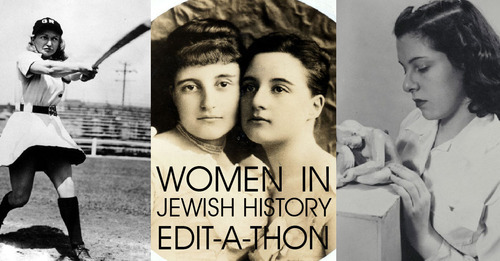By Jackie Brettschneider, Research Intern, Center for Jewish History
Jewish women have played an important role in improving the rights of women in both the secular and Jewish communities. Some Jewish feminists chose to work for the rights of all women and some chose to work exclusively for women’s rights within the Jewish religion. This created a divide between the broader feminist movement that included Jewish feminists, and a specifically Jewish feminism, referring to feminists improving the rights of women specifically within the Jewish religion.
Jewish women were extremely active in feminism before and during the second-wave feminist movement of the 1960s. First-wave feminists fought for women’s suffrage and for the rights of working women, while second-wave feminists fought for birth control rights, the legalization of abortion, and higher education opportunities for women, as well as other forms of women’s rights to gain equality. These Jewish women were different than those who worked exclusively for the rights of women within the Jewish community. These feminists, possibly inspired or influenced by their Judaism, fought to improve the rights of all American women.
Lillian Wald was a leader in the campaign for protective legislation for working women. She helped to form the National Women’s Trade Union League in 1903 and was also a member of the Factory Investigating Commission, which worked to prevent industrial abuses of female workers. She insisted that her work was nonsectarian, although she helped Jewish immigrants and most of her funding came from Jewish philanthropists.
Many Jewish women, such as Maud Nathan, were involved in the suffrage movement. Nathan, according to Jewish Women in America: An Historical Encyclopedia, was the most significant Jewish leader of the suffrage movement. She was the first vice president of New York’s Equal Suffrage League. She invented open-air automobile campaigns, which were speeches given from cars stationed all around New York City. She also invented the popular idea of giving out suffragette pamphlets wrapped around coins. Nathan, unlike Wald, embraced her Judaism, and would quote different biblical texts in her speeches and connect them to the concerns of the time. Influenced by her Judaism, she fought for equal voting rights for all American women.
Betty Friedan became a feminist because of a passion to fight the injustice that she first experienced in the form of anti-Semitism while growing up in Peoria, Illinois. She wrote The Feminine Mystique in 1963, which had an enormous impact in sparking the second-wave feminist movement. She believed that “the feminine mystique” shot down the ambitions of women at that time and kept them at home. In her book she exposed the idea that women weren’t happy with their lives as stay at home mothers.
These Jewish feminists were all inspired or influenced in some way by their Judaism. Wald collected donations from Jewish philanthropists, Nathan embraced her Judaism in her speeches, and Friedan used her experience with anti-Semitism to fuel her fight for the rights of American women. These Jewish feminists chose to help the women of America by fighting for their rights and for their equality, unlike the Jewish feminists whom exclusively worked to gain rights for Jewish women within the Jewish religion.
According to the Encyclopedia Judaica, the earliest pursuit of the rights of women within the Jewish religion was the struggle for more educational opportunities, and for women to lead social service and charity-based organizations. Later in the 1960’s, inspired by the second-wave feminist movement in the United States, there was a push to further increase the rights of women within the Jewish community.
Trude Weiss-Rosmarin wrote the article, “The Unfreedom of Jewish Women,” which criticized the disadvantages of women in Jewish law, and Rachel Adler wrote an article that exposed the status of women in Jewish tradition. According to the Jewish Women in America: An Historical Encyclopedia, these two articles written in 1970 were very influential and inspired many women to become feminists throughout the Jewish community. Eventually a public organization was formed called Ezrat Nashim which fought for equal access of men and women to hold the position of rabbi or cantor.
Feminists fought for women’s rights within the Jewish religion in many different ways. One strategy in particular that was greatly used was writing. Many articles were written in different sources such as Response magazine, a magazine devoted to Jewish feminism created in 1973. In 1976, Lilith magazine was created as a major platform for Jewish feminists to write about their efforts. These magazines allowed the Jewish feminist movement to spread its message and gain more followers.
The efforts of many Jewish feminists and their supporters allowed for the introduction of baby-naming ceremonies for girls and feminist Passover Seders. 1955 saw an increase in congregations that allowed women to be called up to read the Torah. In 1972, the Hebrew Union College ordained the first female rabbi in the United States, Sally Priesand. In 1975, the same college graduated its first female cantor. In 1973, it was ruled by the Committee on Jewish Law and Standards of the Conservative Rabbinical Assembly that women could be part of a Minyan. Unlike the mainstream feminism performed by Wald, Nathan and Friedan, Jewish feminism allowed for these changes to occur within the Jewish community and religion.
For more on “Feminism” and “Jewish Feminism” see:
Hyman, Paula, Deborah Dash Moore, and Phyllis Holman Weisbard. 1997. Jewish women in America: an historical encyclopedia. New York: Routledge. http://search.cjh.org/beta:CJH_ALEPH000078665
I referenced the following articles specifically:
Feminism, American [Volume I, pg. 408]
Jewish Feminism [Volume I, pg.694]
Nathan, Maud [Volume II, pg. 967]
Wald, Lillian [Volume II, pg. 1446]
Friedan, Betty [Volume I, pg. 482]
Encyclopedia Judaica – “Feminism”
Lilith Magazine http://search.cjh.org/beta:CJH_ALEPH000128707
The archives at the Center for Jewish History

